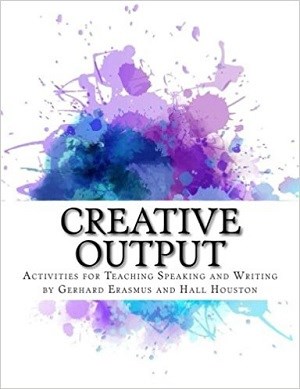Creative Output: Activities for Teaching Speaking and Writing, CreateSpace Independent Publishing Platform 2017
 Creative Output: Activities for Teaching Speaking and Writing
Creative Output: Activities for Teaching Speaking and Writing
Gerhard Erasmus and Hall Houston 2017
CreateSpace Independent Publishing Platform
The focus of Hall Houston’s new writing venture, in collaboration with Gerhard Erasmus, is to help learners improve their fluency in speaking and writing, build their confidence and ability to learn autonomously, and provide an outlet for creativity and fun.
The differences between writing and speaking are explored in the Introduction, the main difference being the permanence of writing and the immediacy of speaking, and what that means for the classroom. For both skills, tasks need to be level and age appropriate (obviously) and there needs to be a communicative purpose. Specifically, for speaking, we need to ensure that tasks for more than one speaker are reciprocal, that they are somewhat predictable, and that they are meaningful for the students. Unless recorded for review and evaluation, speaking tasks require immediate or slightly delayed feedback since the interaction is soon gone. With writing, we need to have a target audience, a communicative purpose and there needs to be an authentic reason for producing the text. Feedback can be hot or cold (immediate or delayed) and a time frame for the task is usually helpful.
Under Activities, there are six sections: Speaking activities, Writing activities, Speaking and writing activities, From input to output, Book-based activities and Young learners activities. As Hall and Gerhard state, they have tried to offer twists and variations to old activities. This includes adding extra notes on how the tasks could be altered.
As I read through, I made note of the tasks I thought my own students might enjoy. I am currently teaching a literacy class and an elementary class. While my lessons are focused on general English, all of my students will be going into the gas and oil sector eventually, so I was also keeping an eye out for activities that could be adapted to suit their particular needs.
The first Speaking task I gravitated towards was, Read, Draw and Retell. In this, students are given a story to read and then have to tell it to a partner who has to draw the whole story or one element in it. My students in the Gulf find it difficult to work in pairs in this way. They prefer to tell each other the answers rather than ask questions to discover the answers. This task would give them a real reason to do the task.
Enhanced Storytelling expands on the storytelling idea. Students have a box with 15 squares in it and they have to make up a story. They must pick up a card and incorporate the information on the card into their story. Students then tell their story based on the cards they hold. For example, the card could say ‘Use facial expressions to highlight your story’ or ‘Add a few unusual details to your story’. In this way, the stories are made more entertaining. Information Gap with Menus can be done with any menu from a local restaurant. You make two copies of the menu and then cross out different information on the two different copies. Students must talk to their partner to fill in the gaps in their menu. You can then end the activity by asking students if they have ever eaten at that restaurant, what looks good on the menu and what they would like to try.
In the Writing section, I moved towards the tasks which would get my students up and moving. From Vocabulary to Paragraphs does this beautifully.
Students are given 14 words which are on the board in two separate columns of seven words each. They must come to the board and make a sentence using one word from each column. Students then get into groups and combine their sentences to develop a paragraph. You could take it one step further and combine with the storytelling tasks and have students create a story instead of a paragraph.
Another one I liked was Make a Crossword. I already have my students use the computer to create their own Kahoot!© games, so I think they would like this one too. They can write clues for their crossword or draw pictures. The other students have the same words and have to create a crossword, complete with the appropriate spacing, etc. This ensures cooperation and collaboration.
In Section 5, Book Based Activities, I really liked Facebook Profiles. Students have to fill out a profile in pairs and create a profile for an imaginary person. They can upload a photo or draw it. Depending on your class, you could adapt the task for an online dating site.
There were, however, a few things I didn’t like. As a visual person, the book caught my attention with its bright splashes of paint adorning the cover but when I opened it, I was disappointed. There are no visuals. The tasks themselves only have Preparation and Procedure and nothing in the layout made me want to delve deeper, although once I did, I found some hidden gems.
Were I to offer some advice, I would suggest adding some pictures or colour or putting the tasks into some form of table. A more creative way of presenting the material would suit the title more.
Comments
Write a Comment
Comment Submitted